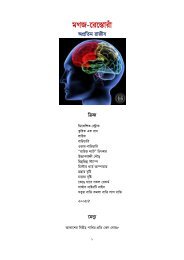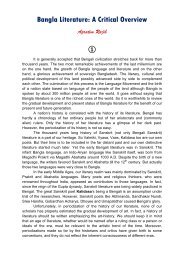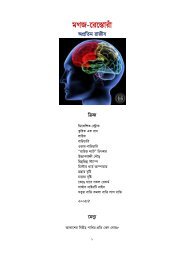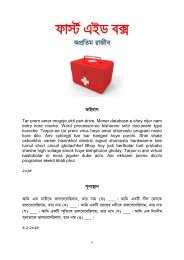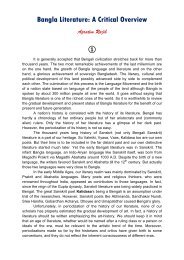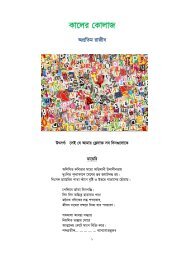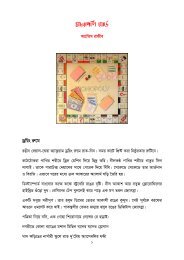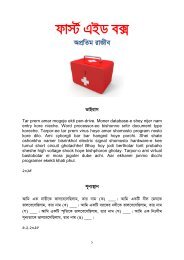BLiterature-Apratim
Create successful ePaper yourself
Turn your PDF publications into a flip-book with our unique Google optimized e-Paper software.
37<br />
autobiographical novel. It is a gigantic work, a mirror of contemporary social attitudes<br />
and an implicit document of Sarat’s own life and outlook.<br />
Sarat lived in an era while the common Bengalis were much more emotional<br />
than they are today. He wrote his novels in empathetic and compassionate language<br />
that makes the reader schmaltzy for the deprived and oppressed.<br />
He not only won the hearts of common readers but also many younger writers<br />
were inspired by his writing techniques; particularly his influence on Tarashankar is<br />
worth mentioning. He had also a deep, long-lasting influence on Bangla cinema.<br />
Personally Sarat believed in conservative and rigid ideas about society and<br />
politics. His personal letters reveal this fact.<br />
But through his literary works, Sarat fought against all crude and inhuman<br />
social oppressions. Such height in the language of protest against social evils is rare<br />
in his contemporary Bengali writers’ works. We pay our homage to the ‘Oporajeyo<br />
Kothashilpi’ (i.e. Invincible Fictionist) as a visionary of human well-being, as a great<br />
rebel against all evils of a backward and decadent society.<br />
Kazi Nazrul Islam (1899-1976)<br />
India’s political and economic life went through a great upheaval in the first<br />
half of the 20 th century. The colonial rulers intensified their atrocities; the whole<br />
country turned to a large crematorium. Its vivid sign was in the Amritsar massacre of<br />
1919. Economic exploitation made the nation continuously poorer day by day. The<br />
agitation against the injustice done by the British rulers gradually increased and it<br />
eventually led the nation to its independence. That disrupted era of struggle for<br />
freedom found its best artistic exposure in Nazrul’s poems. He gave birth to a typical<br />
style and diction, which conveys the tone of heartrending protest.<br />
Nazrul is commonly known in Bengal as the ‘Rebel Poet’, as the epitome of<br />
Bengali nationalism and independence. Perhaps no other poet of the world has<br />
expressed so artistically the firm voice of protest against tyrant rulers. But his entire<br />
reputation does not lie merely in these traits. He was also a poet of love, a classical<br />
musician and a skilled translator of Persian and Arabic poems. Not only that; he also<br />
brought Middle Eastern and Hindustani artistic flavor into our literature.<br />
His immortality in Bangla literature is mainly for his first book of poems<br />
Agnibina (The Harp of Fire). However, he has another quite similar work titled Bisher<br />
Bashi (The Flute of Poison).<br />
“Bidrohi” (“The Rebel”), which is widely recognized as his immortal<br />
masterpiece, is a great example of pluralistic ideas. Themes and characters of<br />
Indian, Greek and Middle Eastern mythologies are assimilated here. He professed<br />
his vision of himself as a poet of love and rebellion in the following line of the poem,<br />
“A curbed bamboo-flute is in my one hand, in the other a war-drum.”<br />
(Translated by the author)<br />
In “Raktambardharini Ma” (“Red-colored Mother”) and “Agamani” (“The<br />
Coming Deity”), he presents goddess Durga symbolized as the opponent to demonlike<br />
imperial power.




